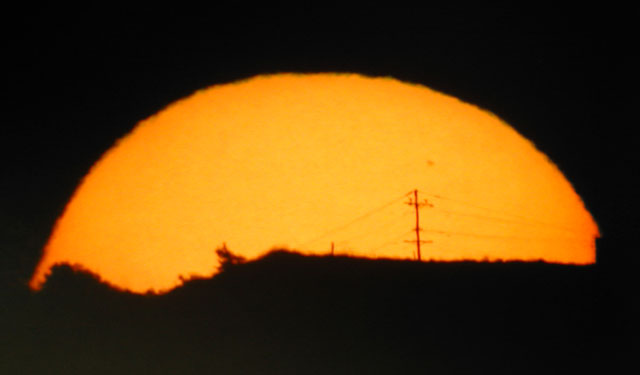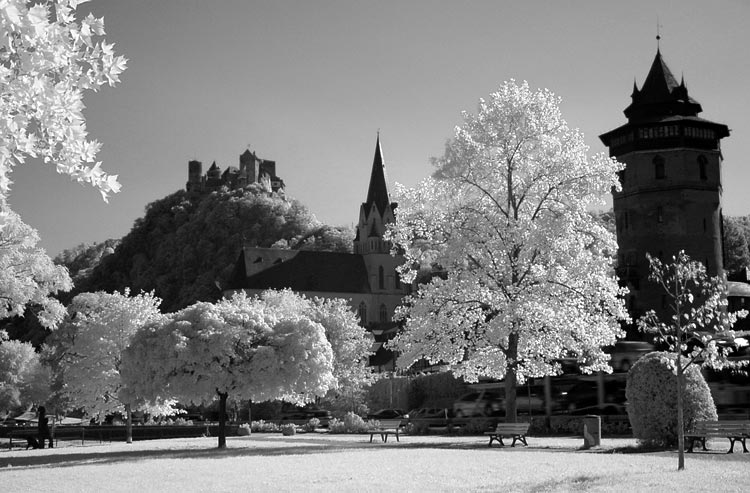|
1. The
Photon, Infrared and the Panacea Filter:
The Photon.
A single photon
is a weird thing. It's an electric charge in one direction with
a magnetic field 90 degrees perpendicular to it. And, just to
make it seem stranger, it is moving at 186,000 miles every second
(300,000 kilometers per second).
Okay, you
knew that. It's the Speed Of Light. Everybody knew that.
The photon
doesn't wear out. The only thing that can happen to it is that
it gets absorbed fully or partially by matter that has the property
of "opacity." Or, it can be perceived as having a longer
or shorter wavelength if astronomical distance phenomena get
invoved. Red shift won't be a problem for you in your digital
photos.
These little
energy clumps each define one wavelength. But the size of that
wavelength can be from microwave size (a fraction of an inch)
up past X-ray size (a fraction of a molecule). Our eyes are interested
in the 700 to 400 nanometer photons--less than a one-octave range
of frequencies. Photons in the 900 to 700 nanometer range are
longer, lower energy and "redder" than red. Infrared.
 The
span of photographable light frequencies that reach the Earth's
surface from the sun is several octaves and statistically centers
on the energy range we see. The
span of photographable light frequencies that reach the Earth's
surface from the sun is several octaves and statistically centers
on the energy range we see.
Mother Nature
is no dummy, so when she was passing out the eyes, she made them
efficient. "No sense looking for photon frequencies that
show low demographics. I'll concentrate on the more populated
ones," she said in a recent interview.
For an organism
to see infrared directly involves stranger and stranger light
sensitive cells and optical systems than the ones we have in
our heads. Mother Nature's comment; "Trust me, you do NOT
want to carry around six-inch eyeballs."
For the small
sub-set of animals that have color vision--primates and birds,
notably--the strong mid-range we call the visible spectrum is
easy to detect, and by sensing separate colors in our brains,
we can find ripe food using visual cues more easily.
At the top
end of the visible spectrum, we see photons as blue. In the middle, we see them as green. Each one, being a single wavelength, is a pure
color. In fact, each photon is the purest color imaginable. There
are no white photons. But are there purple ones?
As these infrared
photons shoot out of the sun and slam down through the atmosphere,
they bounce off things or get absorbed just the way the visible
ones do.
Leaves need
photons to interact with their chlorophyll to make starches and
sugars out of oxygen, carbon and hydrogen plus a pinch of nitro.
But they don't find infrared photons particularly useful, so
they kick them away and don't absorb them.
A-HA! That's
why infrared shots of foliage show the leaves as white!
And that's
why people like to play around with infrared. For all its strange
physics, it becomes a tool for seeing differently. Peoples' faces
look strange, the sky looks black sometimes, and man-made colors
behave unpredictably. (The sky only looks blue because it scatters
blue photons--red ones don't scatter, and infrared ones really
don't scatter.)
Reflections
in a reddened eye:
Objects in
our world reflect certain colors. Actually, they absorb certain
colors that are the exact opposite of the colors we see them
as. Red paint absorbs blue and green photons and bounces out
the red ones. And so on.
What escapes
the notice of our eyes is that pigments and dyes often reflect
portions of the spectrum that are separated. Purple plants, inks
and pigments bounce both the red and blue parts of the spectrum
while absorbing the middle gold, yellow, green and cyan portion.
And it gets more complex than that.
A bunch of purple photons?
Guess again. On close inspection, red ones and blue ones are
here. There are no purple photons. You are seeing a mixture.
In the case
of plants, they like the visible red and blue parts of the sun's
rays, but don't like the green so much. We think of them as "greenery"
but what they really don't want is all that green color they
kick out of the leaves. The do like the red, but only the part
we see. Many green plants throw away nearly all the infrared
photons that hit them.
Getting
the F707/717/V1/828 to see infrared.
When you click
to NightShot mode, you hear a distinct mechanical "thwack"
inside the camera. That's a filter being swapped out of the optical
path. It's job is normally to block infrared rays from reaching
the imaging chip, because the chip is extremely infrared sensitive.
A piece of glass that passes infrared light is substituted so
optical focus isn't changed.
The camera
assumes that you will be shooting in the dark, so it switches
on its infrared LED emitters. You can see these as showing deep
red if you view them in a dark environment, and they let you
shoot in zero light. In Night Flash mode, they help focus the
camera and find the view, but for daylight shots, they just get
in the way.
There is a
problem with this in that the emitters are now behind any filter
you put over the lens. And this article is about the Panacea
Filter which goes over the lens. Emitter light will bounce
off the back of the filter and into the camera on the 707/717.
Hold that
thought.
Sony has decided,
as a matter of prudence, to limit the IR viewing abilities of
the 707/717/V1/828 to indoor viewing and shooting. They did this
because IR shows somewhat through certain clothing and people
were calling this the "naked mode" in earlier video
cameras that feature the zero light abilities that the 7x7/V1/828
cameras have inherited.
Not kidding.
A woman wearing certain fabrics and no bra can be slightly seen
to have nipples under her blouse in bright infrared light. You
can imagine the middle American Puritanical outcry, "We
don't want our wives and daughters to be known for having nipples!"
or some such. Sony bent to American prudence and limited their
cameras to NightShot mode, making it shoot only 1/60 sec or slower
using auto exposure. (1/30th on the 828)
That's too
bright for daytime shooting. Way too bright. When the IR filter
is out of the optical path, even ISO 100 sensitivity jumps through
the roof. And in NightShot mode, Auto ISO setting, the camera
will produce up to ISO 2500!!
On the surface
of the imaging chip, the red, green and blue filters that separate
out the colors don't affect IR light very much. Long IR photons
sail right through them. That's good for shooting in weak IR
illumination, like the camera's emitters, but it makes daylight
shooting of IR subjects problematic.
The usual
IR shooting stack consists of three filters: An IR filter such
as an R72, and two neutral density filters to cut back the total
amount of light entering the lens. This stack of parts costs
about $65 from www.2filter.com and generally works well.
But what if
you simply cut out the visible light and took advantage of NightShot's
extreme sensitivity to infrared? Would that work?
Yes. And that's
just what the Panacea Filter does:

No
IR filter was used to capture this shot in the Rheinland. And
the temperature outside was a balmy 76 degrees, so that white
stuff could NOT be snow. If I had used a real IR filter, the
sky would have been much darker, too.
The Filter
in Question;
The Panacea
Filter is a rare and extreme filter. It's called an ND-400 and
it costs about the same as the IR stack mentioned above if you
get it from www.2filter.com. I've seen it in 58mm as high as
$135. You have to want it.
We are used
to the nomenclature of ND (Neutral Density) filters, where ND-8
is a three-stop reduction of light (A.K.A "0.9" in
Tiffen nomenclature) but what does an ND-400 do? It cuts the
heck out of the light so completely that there isn't much left.
Less than a quarter of 1% of the original light gets through.
And even though
it cuts the visible spectrum way down, the infrared sensitivity
of the camera in NightShot mode is way up. The IR light makes
pictures, and the visible light is almost completely drained
from the shot. But not absolutely completely.
Blue sky still
has some faint color. Bright neon signs can show color, too.
It's unpredictably selective, but since you can view things live
through it, you will see a different world. And a world of new
imaging possibilities.
But what about
the emitters in the 707/717? They won't put out enough light
to ruin noon shots in full daylight, but they will be a hassle
in dim light. Use the same emitter light controlling trick outlined
in the Sony eBook and you won't have a problem.
Note that
a true IR filter gives a cleaner IR result. The image up there
was tweaked in Photoshop to get the contrast up.

2. Time
Span Increased.
Since the
ND 400 lets in about 1/500th of the normal range of light, it
finds another interesting uses in regular color shooting mode.
It makes moving
objects speed up by 500 times. Any image you would normally shoot
at 1/500 sec will now need 1 sec to expose. And if that object
moves, it becomes a blur, a ghost of its former self. Longer
exposures can almost entirely erase anything that moves.

See
the people on the escalator? I did. Where did the steps go?
Stacking the
ND 400 with other ND filters increases the time, proportionally.
A common, low-cost ND8 on top of the ND 400 now makes the example
above require 8 seconds. Close the f-stop down and you might
need dozens, scores or hundreds of seconds to capture an image.
Shoot a stream
and it becomes a pastoral blur of water. Shoot traffic and it
becomes a streak of reflected highlights with no cars visible.
Shoot a rush hour crowd and it becomes an image of ghosts vaporously
whisking over the background.

Dozens
of happy shoppers traverse the busy plaza. I saw them with my
own eyes. But only one lonely reader sits under the umbrella
in the shot. Wait a minute, I think I see someone else...
Stack two
and the exposure factor goes up to 250,000 times normal. A 1/125th
sec exposure now becomes 2,000 seconds, and that's over half
an hour. Clouds become blurred, animal cages show only dozing
creatures, theme parks become sunlit wastelands and shadows take
on an airbrushed quality.
There is a
lot to play with inside this single filter.

 More will be here as the Sony Zone pages
evolve. More will be here as the Sony Zone pages
evolve.
-iNova
PS: As
experience grows with these cameras, so will this review and
the Sony eBook. Available now on the order page.

© 2004 Peter iNova.
All rights reserved. Do not replicate or link to images without
permission. All photos by Peter iNova unless attributed to others.
Photos are the copyright of their originators.
|


 The
span of photographable light frequencies that reach the Earth's
surface from the sun is several octaves and statistically centers
on the energy range we see.
The
span of photographable light frequencies that reach the Earth's
surface from the sun is several octaves and statistically centers
on the energy range we see.

